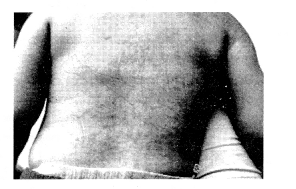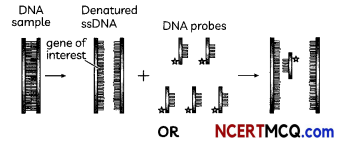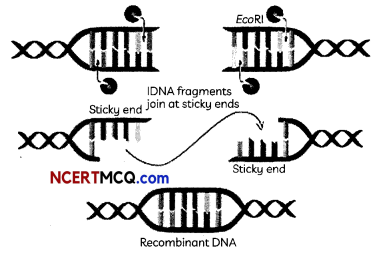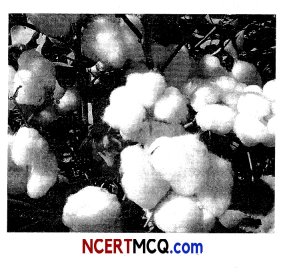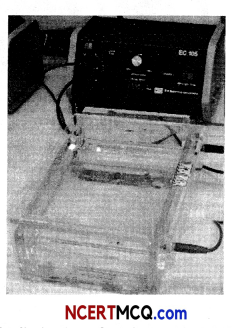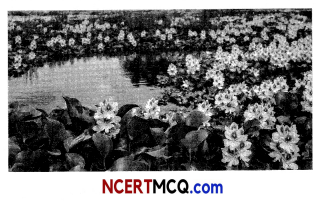Students can access the CBSE Sample Papers for Class 12 Economics with Solutions and marking scheme Term 2 Set 8 will help students in understanding the difficulty level of the exam.
CBSE Sample Papers for Class 12 Economics Term 2 Set 8 with Solutions
Time allowed: 2 Hours
Maximum Marks: 40
General Instructions:
- This is a Subjective Question Paper containing 13 questions.
- This paper contains 5 questions of 2 marks each, 5 questions of 3 marks each and 3 questions of 5 marks each.
- 2 marks questions are Short Answer Type Questions and are to be answered in 30-50 words.
- 3 marks questions are Short Answer Type Questions and are to be answered in 50-80 words.
- 5 marks questions are Long Answer Type Questions and are to be answered in 80-120 words.
- This question paper contains Case/Source Based Questions.
![]()
Question 1.
“Gross investment is always greater than net investment.” Defend or refute the given statement with valid argument.
OR
“Net factor income from abroad can never be negative.” Defend or refute the given statement with valid argument. (2)
Answer:
The given statement is refuted. Net factor income from abroad is the difference between factor income earned from rest of the world and factor income paid to rest of the world.
If the value of factor income paid to rest of the world is greater than the factor income earned from rest of the world, the resulting value (net factor income from abroad) can be negative.
OR
The given statement is refuted. Gross investment includes addition to capital stock which also includes replacement for the normal wear and tear (depreciation).
Whereas, addition to capital stock in an economy is measured by net investment. So, in an accounting sense, if the value of depreciation becomes zero, only then gross investment will be equal to net investment.
![]()
Question 2.
Calculate consumption expenditure in the economy whose equilibrium level of income is ₹20,000, autonomous consumption is ₹500 and marginal propensity to save is 0.5.
OR
S = – 100 + 0.2 Y is the saving function in an economy. Investment expenditure is ₹5,000. Calculate the equilibrium level of income.
Answer:
C = \(\bar{C}\) + (1 – MPS)Y
= ₹500 + (1 – 0.5) ₹20.000
C = ₹500 + ₹10,000 = ₹10,500
OR
S = -100 + 0.2Y
At equilibrium
S = I
I = ₹5.000
₹5.000 = – ₹100 + 0.2Y
0.2Y = ₹5.100 Y
= ₹25.500
Question 3.
“Aggregate Demand worldwide has collapsed and non-essential expenditure is being postponed due to the spread of Covid-19.”
State any two monetary measures to correct the above situation. (2)
Answer:
- Open market operations (buying securities)
- Reducing bank rate
![]()
Question 4.
Discuss the need for on-the-job training for an employee.
OR
Analyze the date given in the below table:
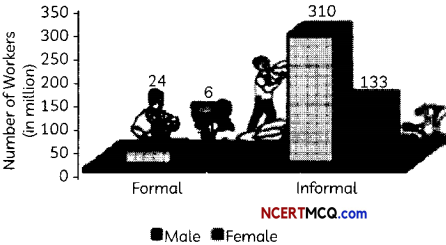
Answer:
Employers use on-the-job training methods for its employees to target an overall increase in the skills and efficiencies of the workers. On-the-job training lead to an increase in productivity of labour and production of goods. Such trainings keep the employees updated with the latest changes in their field of working.
OR
There were about 30 million workers in the formal sector, i.e., about only six percent (30/473×100). Thus, the rest 94 percent are in the informal sector. About 20 percent of formal sector and 30 percent of informal sector workers are women. About 80 percent of formal sector and 70 percent of informal sector workers are men. It can be concluded that is necessary to generate employment in the formal sector rather than in the informal sector.
![]()
Question 5.
“Women’s health became a matter of great concern in India till the health of a woman is not a priority in our country.” Explain. (2)
Answer:
Women constitute approximately half of Indian’s total population, but they suffer from many disadvantages in health care. Traditionally, women health care had been on the back burner in India due to social considerations prevailing in the country. Gender ratio in the country is declining. The growing rate of female foeticide in the country is also a cause of concern. Most of the married women suffer from anaemia and nutritional anaemia leading to maternal deaths.
Question 6.
Giving reason, explain how should the following be treated in estimating gross domestic product at Market Price.
(A) Fees to a mechanic paid by a firm.
(B) Interest paid by an individual on a car loan taken from a bank.
(C) Expenditure on purchasing a car for use by a firm. (3)
OR
If NDPfc = 4,300, depreciation = 1,350, subsidies = 250, net factor income from abroad = 330, What will be the value of GDPmp?
Answer:
(A) Fees paid to the mechanic by a firm: It is not included because it is an intermediate cost of the firm.
(B) Interest paid by an individual: It is not included because the loan is taken to meet consumption expenditure and therefore, interest paid on such a loan is not a factor payment.
(C) Expenditure on purchasing car by a firm: It is included because it is an investment expenditure, a final expenditure.
OR
GDPmp = NDPfc + Depreciation – Subsidies
= 4,300 + 1,350 – 250
= ₹5.400
![]()
Question 7.
Analyze and compare the distribution of workforce in rural and urban areas.
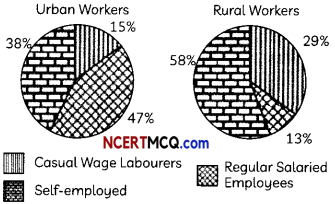
Read the following case carefully and answer question number 8 and 9 given below;
Why China is looking at a three-child policy?
China embarked upon its one-child policy in 1980, when the Communist Party was concerned that the country’s growing population, which at the time was approaching one billion, would impede economic progress.
Chinese authorities have long hailed the policy as a success, claiming that it helped the country avert severe food and water shortages by preventing up to 40 crore people from being born.
However, the one-child limit was also a source of discontent, as the state used brutal tactics such as forced abortions and sterilisations. It also met criticism and remained controversial for violating human rights, and for being unfair to poorer Chinese since the richer ones could afford to pay economic sanctions if they violated the policy.
Additionally, China’s rulers have been accused of enforcing reproductive limits as a tool for social control The supposed benefits of the policy have also been questioned. Due to the policy, while the birth rate fell, the sex ratio became skewed towards males. This happened because of a traditional preference for male children in the country, due to which abortion of female fetuses rose and so did the number of girls who were placed in orphanages or abandoned.
Experts have also blamed the policy for making China’s population age faster than other countries, impacting the country’s growth potential. It is also suggested that because of the long-lingering impact of the policy, China would be unable to reap the full benefits of its economic growth and will need other ways to support it – unlike India and other Asian economies such as Indonesia and the Philippines, who have young populations. India’s population, for instance, will start ageing from the middle of this century onwards.
![]()
https://indianexpress.com/article/explained/china-population-three-child-policy-7463114/
Answer:
The self-employed and casual wage labourers are found more in rural areas than in urban areas. In the latter, both self-employment and regular wage salaried jobs are greater. In the former, since majority of those depending on farming own plots of land and cultivate independently, the share of self-employed is greater. The nature of work in urban areas is different. Obviously everyone cannot run factories, shops and offices of various types. Moreover enterprises in urban areas require workers on a regular basis.
Question 8.
“There are some advantages to the one-child policy. Which helped to develop the country’s economic status.” State and discuss any two benefits that China got from One-child Policy. (3)
Answer:
Advantages:
(i) Population control: Most common advantage of the One-child policy is control of the population. Where there will be a decrease in the birth rate. Chinese government estimated that some 400 million births were prevented by the policy.
(ii) Avert severe food and water shortages: One Child policy helped the country avert severe food and water shortages by preventing up to 40 crore people from being born.
Question 9.
As there are some ups, there are also some downs to the one-child policy. These downs can affect on the country in every aspect socially and economically.” State and discuss any two consequences of One-child Policy to China. (3)
Answer:
The consequences of one child policy to China are:
(i) Imbalance in sex ratio at birth: Due to the policy, while the birth rate fell, the sex ratio became skewed towards males because of the preference of boy more than girl by parents. This affected China both socially and economically.
(ii) Decreasing in growth rate: There is less working Labour because policy made China’s population age faster than other countries. It reduced the country’s growth potential. It is also suggested that because of the long-lingering impact of the policy, China would be unable to reap the full benefits of its economic growth.
![]()
Question 10.
Government spends on child immunization programme. Analyse its impact on Gross Domestic Product and welfare of the people. (3)
Answer:
Government spending on child immunization programme is government consumption final expenditure. Therefore, it raises GDP. Since such a programme improves health, it will raise efficiency Level of people and increase welfare.
Question 11.
“India’s central bank will likely to keep interest rates at record lows amid the emergence of new Covid-19 variant Omicron across the world.”
Identify and explain the policy of RBI stated in the above line. Explain any two tools of this policy. (5)
Answer:
Monetary policy
Monetary policy is a policy relating credit control, interest rates and money supply, with the aim of combating excess or deficient demand. This policy is taken by the Central Bank of the country.
Tools of Monetary Policy:
(i) Bank rate: Bank rate is that rate of interest at which the Central Bank lends money to the commercial banks. In case of deficient demand, there is a need to liberalize credit. It can be done by reducing bank rate so that the commercial banks also reduce their lending rate, thereby increasing the availability of credit in the economy. In case of excess demand, there is a need to restrict credit. Thus, bank rate is increased.
(ii) Margin Requirement: Margin requirement is the difference between amount of loan offered and the market value of security offered against the loan. Higher the margin requirement Lesser will be the demand for loan. In this situation of excess demand, there is a need to restrict loan/credit which can be done by raising the margin requirements. In this situation of deficient demand, there is a need to increase loan/ credit which is done by decreasing the margin requirements.
![]()
Question 12.
Given the following data, find the missing values of ‘Private Final Consumption Expenditure’ and ‘Operating surplus’.
| Particulars | Amount (in ₹ crores) |
| National Income | 50,000 |
| Net Indirect Taxes | 1,000 |
| Private Final Consumption Expenditure | ? |
| Gross Domestic Capital Formation | 17,000 |
| Profits | 1,000 |
| Government Final Consumption Expenditure | 12,500 |
| Wages & Salaries | 20,000 |
| Consumption of Fixed Capital | 700 |
| Mixed-Income of Self Employed | 13,000 |
| Operating Surplus | ? |
| Net Factor Income from Abroad | 500 |
| Net Exports | 2,000 |
OR
Given the following data, find the values of “Gross Domestic Capital Formation” and “Operating Surplus”. (5)
| Particulars | Amount (in ₹ crores) |
| (i) National Income | 22,000 |
| (ii) Wages & Salaries | 12,000 |
| (iii) Private Final Consumption Expenditure | 7.200 |
| (iv) Net Indirect Taxes | 700 |
| (v) Gross Domestic Capital Fomation | ? |
| (vi) Depreciation | 500 |
| (vii) Government Final Consumption Expenditure | 6,100 |
| (viii) Mixed-Income of Self Employed | 4,800 |
| (ix) Operating Surplus | ? |
| (x) Net Exports | 8,400 |
| (xi) Rent | 1,200 |
| (xii) Net Factor Income from Abroad | (-) 150 |
Answer:
Operating surplus = (i)-[(vii)+(ix)+(xi)]
= 50,000 -(20,000 + 13,000 + 500)
= 16,500 crores
Private final Consumption expenditure = (i) – [(iv) + (vi) + (xi) + (xii)] + (vii) + (ii)
= 50000 – (17000 + 12500 + 2000 + 500) + 700 + 1000
= ₹19,700 crores
OR
Gross Domestic Capital Formation = (i) – {iii + vii + x} + vi – xii + iv
GDCF = 22,100 – {7,200 + 6, 100 + 3, 400} + 500 – (-150) + 700
GDCF = ₹6,750 crores
Operating surplus = National Income – wages and salaries – Mixed Income of Self Employed – Net Factor Income from Abroad
= (i) – (ii) – (viii) – (xii)
= 22,100 – 12,000 – 4,800 – (-150)
= ₹5,450 crores
![]()
Question 13.
(A) Define the worker-population ratio. What does it signify?
(B) Discuss any two reforms which have been initiated recently to meet the energy crisis in India. (5)
Answer:
(A) Worker-population ratio is calculated by dividing the total number of workers in a country by the population of the country and multiplying it by 100. The worker-population ratio is an indicator which is used for analysing the employment situation in the country. This ratio is useful in knowing the proportion of population that is actively contributing to the production of goods and services of a country.
(B) Two reforms to meet energy crisis in India are as follows:
- Improvement in Plant Load Factor has increased the operational efficiency of the power stations.
- Check on transmission and distribution losses have reduced the transmission losses and saved a lot of funds for the power distribution companies.
